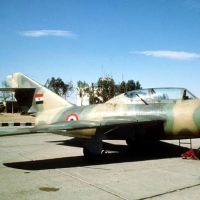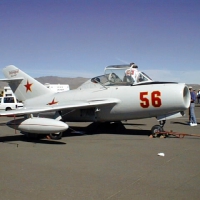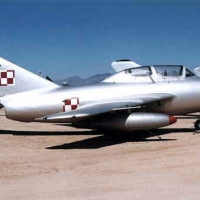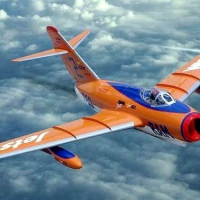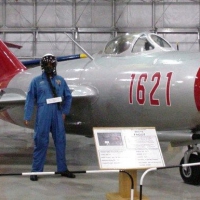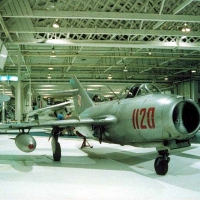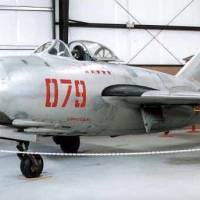MiG-15 Fagot
 From the end of the Second World War the USSR undertook a vast development program for modem jet-powered warplanes, and the first classic fighter to emerge was the swept-wing MiG-15, which flew in December 1947 as the 1-310 with a Rolls-Royce Nene II turbojet. The Nene was copied in the USSR as the RD-45, and in its improved RD-45F version this was used in the MiG- 15 production fighter, which entered service late in 1948.The MiG- 15 was extensively operated by the communist forces in the Korean War (1950-53), and its first-class performance and firepower came as a nasty surprise to the Western nations until ultimately the MiG- 15 and improved MiG- 15bis were equaled by the North American F-86 Sabre. Soviet production continued up to 1951 and was complemented by Chinese, Czechoslovak, and Polish production to build 5,000+ single-seaters and 3,000+ two-seaters.
From the end of the Second World War the USSR undertook a vast development program for modem jet-powered warplanes, and the first classic fighter to emerge was the swept-wing MiG-15, which flew in December 1947 as the 1-310 with a Rolls-Royce Nene II turbojet. The Nene was copied in the USSR as the RD-45, and in its improved RD-45F version this was used in the MiG- 15 production fighter, which entered service late in 1948.The MiG- 15 was extensively operated by the communist forces in the Korean War (1950-53), and its first-class performance and firepower came as a nasty surprise to the Western nations until ultimately the MiG- 15 and improved MiG- 15bis were equaled by the North American F-86 Sabre. Soviet production continued up to 1951 and was complemented by Chinese, Czechoslovak, and Polish production to build 5,000+ single-seaters and 3,000+ two-seaters.
| MiG-15 Fagot Specification | ||
| Prime contractor: | Mikoyan-Gurevich Design Bureau | |
| Country of origin: | Soviet Union | |
| NATO codename: | Fagot | |
| Function: | Fighter | |
| Crew: | 1 | |
| Year: | 1948 | |
| In-service year: | 1949 | |
| Power plant: | One Klimov VK-1 turbojet (copy of British Rolls-Royce RD45F “Nene” engine) | |
| Thtust: | 5,940lb. | 2,700 kg. |
| Dimensions | ||
| Wing span: | 33 ft. 1 in. | 10.08 m. |
| Length: | 35 ft. 6 in. | 10.86 m. |
| Height: | 12 ft. 1 in. | 3.70 m. |
| Weight: | ||
| Empty | 8,098 lb. | 3,681 kg. |
| Max.takeoff | 13,299 lb. | 6,045 kg. |
| Performance | ||
| Ceiling: | 50,840 ft. | 15,500 m. |
| Speed: | 665 mph. | 1,070 km/h |
| Range: | 497 miles (on internal fuel) 882 miles (with two fuel drop tanks) |
800 km.(on internal fuel) 1420 km. (with two fuel drop tanks) |
| Armament | ||
| One N-37 NS-23 23mm cannons with 80 rounds per gun. Max. external weapons load of 500 kg. (1,100 lb.) of bombs, or drop tanks. | ||
| Known Variants | ||
| MiG-15bis, MiG-15UTI | ||
| Operators | ||
| Out of service | ||







